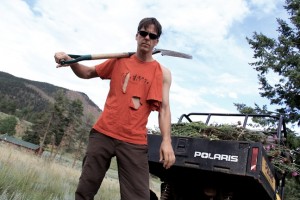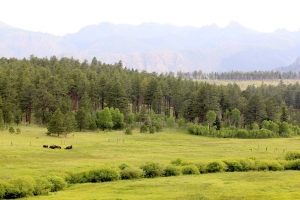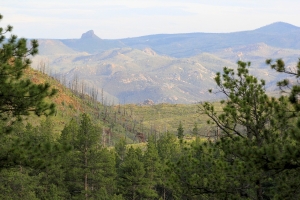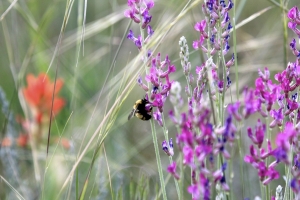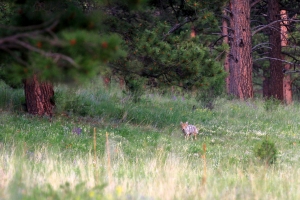Zombies at Buffalo Peak Ranch

Early training …
When we were kids, we spent summers on the family farm in Iowa. Among our many jobs, from mowing the yard to shingling old barns, to painting the white picket fence, we also had to rid the farm of thistles.
My brother and I rode on the back of the old Ford tractor, on a wooden platform with shallow sides connected by two hydraulic arms and a base swivel. My grandfather would take us from the chicken house along the Raccoon River in search of the tell-tale purple flowers, tall above the grass. Our arsenal of tools was a pair of gloves, a sharp knife, and a highly concentrated bottle of herbicide.
The Ford was even then over fifty years of age. Built in the 1930s, it was small but ran well. It’s engine had ample torque that you could count the number of strokes each piston made as the crank shaft went round and round. Slow, methodical, it could climb the steep bank of the river or take us over small fallen logs in the timber.
We would stop every few hundred feet, lower the hydraulic lift, the wooden platform settling to ground. We’d stand up, grab out tools, and spread out. My brother and I would cut the heads off, placing them in an old metal bucket. My mother would then spray the chemical down the hollow neck using a hand-pumped sprayer. My grandfather said this was the only way to make certain they didn’t come back next year.
As with so many things my grandfather taught me, I didn’t come to fully appreciate what I learned until many years later. If only he had known how those long, hot afternoons in the July sun would give me the knowledge to single handedly stop an invading army of Zombies, here on Buffalo Peak Ranch.
… for the real thing.
Alone now, the ranch hand and owner gone, I set out each day to work an hour or two, to earn my keep. A few days ago I left the back porch of the cabin and noticed a few thistles in the distance, just outside the wooden fence. “I’d better take care of those in the morning,” I thought.
When daylight came again, there were a few more. Some of them already inside the fence line. This took me by surprise. I had never seen thistles move that fast before.
These were not your common, Canadian, or milk thistle. Those don’t make much of a fuss. Just as when we were kids, you lop off the flowing head and they’d rarely came back the following year. But these, these were different. More aggressive, intent on claiming territory. From outside to inside the fence in just one day!
I went back inside and looked up types of thistles on the Internet. The reports were not many. Mostly unconfirmed rumours of a mutant strain. But then I found a reference to something that made my skin crawl—a fast moving, aggressive thistle with … with a craving for blood. The Zombie Thistle. The only way to stop them was to get them out of the ground, roots fully exposed to sunlight, and then cut off their heads.
I returned to the back porch and scanned the horizon. My god! They’re everywhere! Should I call the Sheriff? No, his cell phone reception was minimal in the back country. Or the Rabi and campers down the road? No, Catholic priests are much better equipped to deal with the undead. Bruce Campbell? No, getting through his agent would take too much time.
It was me, alone, against all of them.
I pulled on my sturdy boots, work pants, my favourite T, and sun glasses. Once again on the back porch, I counted an additional half dozen thistles, growing tall and strong. The purple heads turned in unison, staring back at me. In just ten minutes time they had doubled in number. An army was forming. I had to act fast before they took over the ranch.
I stepped off the porch and ran to the barn. I could hear their roots reaching through the soil, trying to ensnare my shoes and feet. The sound of their long necks straining.
Don’t look back! Just keep moving!
Once inside the barn, I shut the door behind me. I found a pair of leather gloves, shovel, and the keys to the UTV. I unlatched the front, sliding bay doors and started up the engine. I engaged the four wheel drive, threw open the doors and pressed it into high gear.
The path was yet clear, they had not reached the front of the barn. I drove back to the West, toward the far side of the fenced area, behind the hot tub. They saw me coming, they knew I was prepared.
I stepped from the UTV, walked toward them with the shovel in hand. They hesitated. Some withdrew. That was the moment I needed—I attacked!
I knelt low to the ground. With their vision less keen than their sense of smell, I hoped to remain downwind and catch the first few off guard.
I raised the shovel high, slammed it into the ground at the base of the first Zombie. The soil was hard and rocky. I missed my target and managed to only partially cut the base of the four foot tall monster. It turned, raised its horrid purple head, and leaned back to attack. It lunged forward and I was too slow. It caught my shirt, tearing at the fabric as I fell back on my hands in the mountain meadow. The shovel fell.
I rolled to one side as another two, then three attacked. But this time, my shovel found home and two heads came free. An acrid odour filled the arena and white blood sputtered from the necks of the decapitated thistles.
I jumped to my feet, knowing I had little time before they regrew. I raised my shovel again and drove it in hard and fast, at the base of all three of those immediately to my front and side. My foot pressed the shovel in further and then I leveraged the handle down to the ground and the roots came free. Their long, soil ladened tendrils an abomination to this otherwise perfect land, moved wildly, gasping in the direct sunlight and air. A few seconds later, they stopped. Dead.
A momentary calm fell over the meadow. I had struck my first blow. The Zombie thistles knew they had a worthy adversary. I did not hesitate and attacked the next half dozen directly in front of me. They were caught off guard and came free easily, their heads delivering a high pitched scream with each root ball that came free.
Just as I was raising my shovel overhead for another strike, one attacked from behind, more than five feet tall. It was the largest I had ever seen, it’s head the size of my fist and stalk strong enough to lift a car. It tore at my clothing, trying to get to my skin. My left sleeve was torn completely, my favourite shirt ruined.
That made me mad. I took a step back, turned, and attacked with a scream. My shovel sliced through the stem just below the head, back again in the middle, and then at the base. With just a few inches left above the ground, I delivered the final blow, the roots wriggling in the hot afternoon sun, the head and neck spread across the lawn. The stench was overwhelming, I could barely breathe. But the battle had just begun.
Over the course of the next two hours I unearthed more than four hundred of these monsters, their bodies piled high. When I finally came back ’round toward the cabin, approaching from the rear, the Zombie thistles knew they would lose this round. They shrunk in size, reduced in number before I could even come in for the kill.
Exhausted, I drove the blade of my shovel in again and again until every last one was delivered.
I spent the remaining daylight hours cleaning the battlefield, piling the bodies into the back of the UTV. Their legions are amassing near the upper pond in numbers far greater than what I had encountered today.
Tomorrow, it starts all over again.






